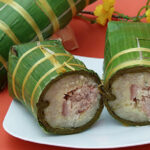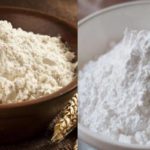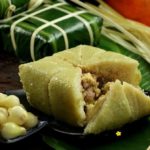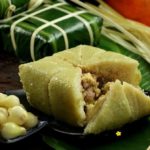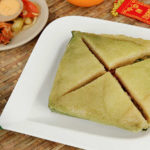Bánh chưng, a traditional Vietnamese sticky rice cake, is gaining popularity not just during the Lunar New Year but all year round. To add to its richness and appeal, people from different provinces have created diverse recipes and ingredients, resulting in unique specialties from each region. Let’s discover 5 special types of bánh chưng below!
Bánh Chưng Nếp Cẩm
Bánh chưng nếp cẩm is a traditional delicacy of the Tày ethnic group, made from the distinctive purple sticky rice of the Northwest region. The cake boasts a striking purple-black color and offers a unique taste and aroma derived from the nếp cẩm rice. Commonly known as black bánh chưng, it is an integral part of the cultural heritage of the Northwest, often present during festivals, fairs, and celebrations.
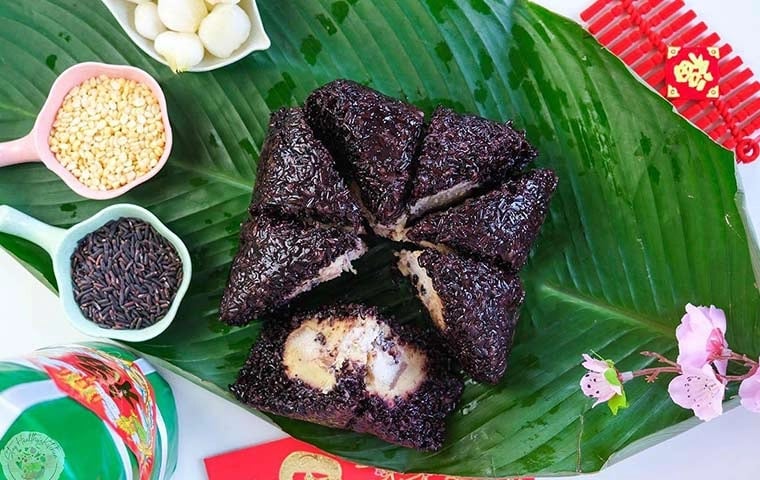
Bánh Chưng Nếp Cẩm – A Tày Ethnic Delicacy
Bánh Chưng Hoa Đậu Biếc
If you adore the classic green bánh chưng but crave a novel experience, bánh chưng hoa đậu biếc is the perfect choice. The cake’s green hue comes from the butterfly pea flower, lending a unique and captivating twist to this traditional delicacy. While the exterior is innovative, the filling remains true to tradition, featuring soft mung beans and fatty pork belly for a familiar yet refreshing taste experience.
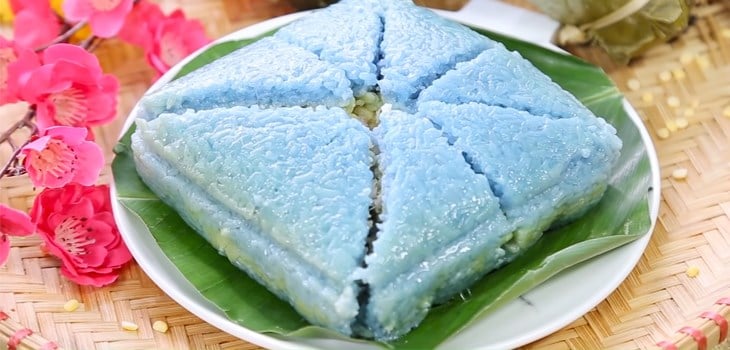
Bánh Chưng Hoa Đậu Biếc – A Refreshing Take on a Classic
Bánh Chưng Gấc
For those who prefer a break from the traditional green, bánh chưng gấc offers a vibrant orange-red hue derived from ripe gac fruit. The process of making this cake remains unchanged from the traditional method, but with the addition of red gac mixed into the sticky rice before wrapping. Bánh chưng gấc is typically prepared with a sweet filling, combining mung beans, sugar, and a touch of lean pork for a uniquely fragrant and delectable taste experience.
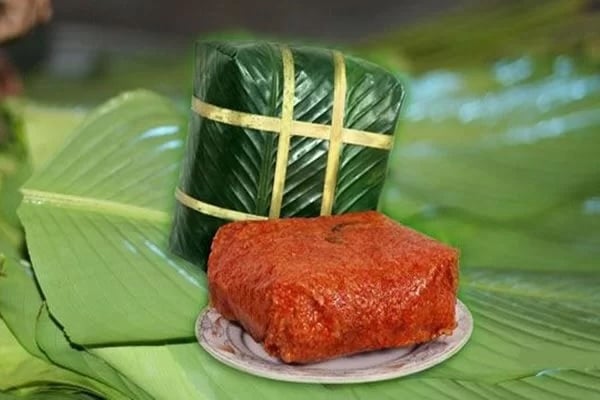
Bánh Chưng Gac – A Vibrant Twist with Sweet Surprises
Bánh Chưng Ngũ Sắc
For lovers of vibrant colors, bánh chưng ngũ sắc is a stunning choice, featuring five distinct colors: green, yellow, purple, red, and white. These colors symbolize the five elements of Kim, Mộc, Thủy, Hỏa, and Thổ, carrying profound spiritual meanings of peace and good luck. Each color on the cake represents a unique flavor, offering a diverse and delightful tasting experience. Bánh chưng ngũ sắc is not just a dish but a meaningful work of culinary art.
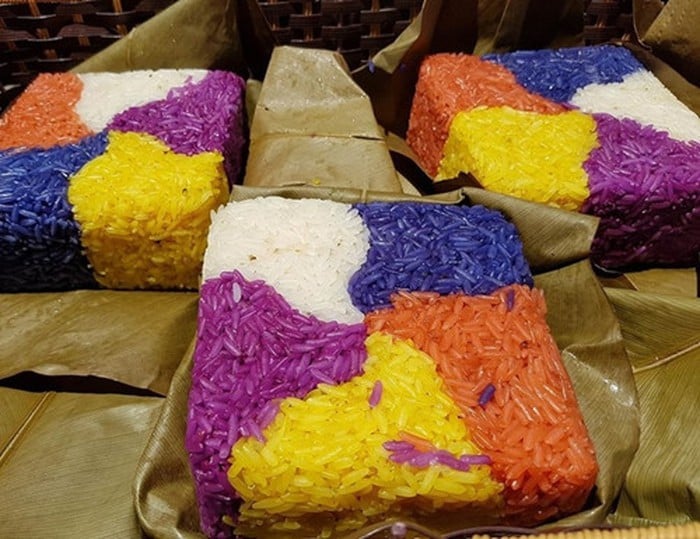
Bánh Chưng Ngũ Sắc – A Colorful Feast for the Eyes and Palate
Bánh Chưng Gù
Bánh chưng gù is a unique specialty of the ethnic minority communities in the mountainous regions, showcasing their creativity in transforming the traditional bánh chưng. Instead of using a square mold, bánh chưng gù is hand-shaped into a crescent moon-like form. Additionally, the ethnic groups often add wild ginger leaves to the filling, imparting a distinctive and memorable flavor. When served, the cake is cut into attractive circles, making it a treat for both the eyes and the taste buds. These unique characteristics set bánh chưng gù apart in both form and flavor.
There are many more fascinating variations of bánh chưng across different regions, each bearing the cultural imprint of its place of origin. Embark on a culinary journey to discover and savor these innovative and delightful treats!
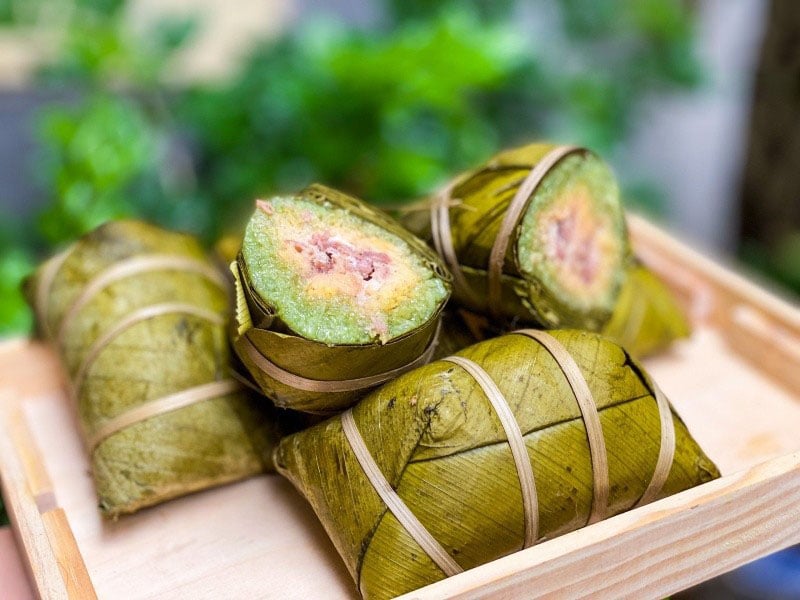
Bánh Chưng Gù – A Mountainous Delicacy with a Creative Twist
The Ultimate Guide to Cooking Delicious Sticky Rice for Bánh Tét
Everyone wants to try their hand at making a delicious and traditional Vietnamese sticky rice cake, but the secret to a truly mouth-watering bánh tét lies in mastering the art of frying glutinous rice. Learn from the pros and discover the time-honored techniques for frying sticky rice to perfection. It’s a skill that will elevate your bánh tét to new heights of deliciousness!
Differentiating Rice and Glutinous Rice Flour
Rice flour and glutinous rice flour are two distinct types of flour that are commonly used in Vietnamese cuisine. At a glance, they might appear similar, but there are key differences that set them apart. Let’s delve into these differences and explore how they can impact your cooking and baking endeavors. These two flours have their own unique characteristics, and understanding these nuances will help you utilize them effectively in your culinary creations.

























